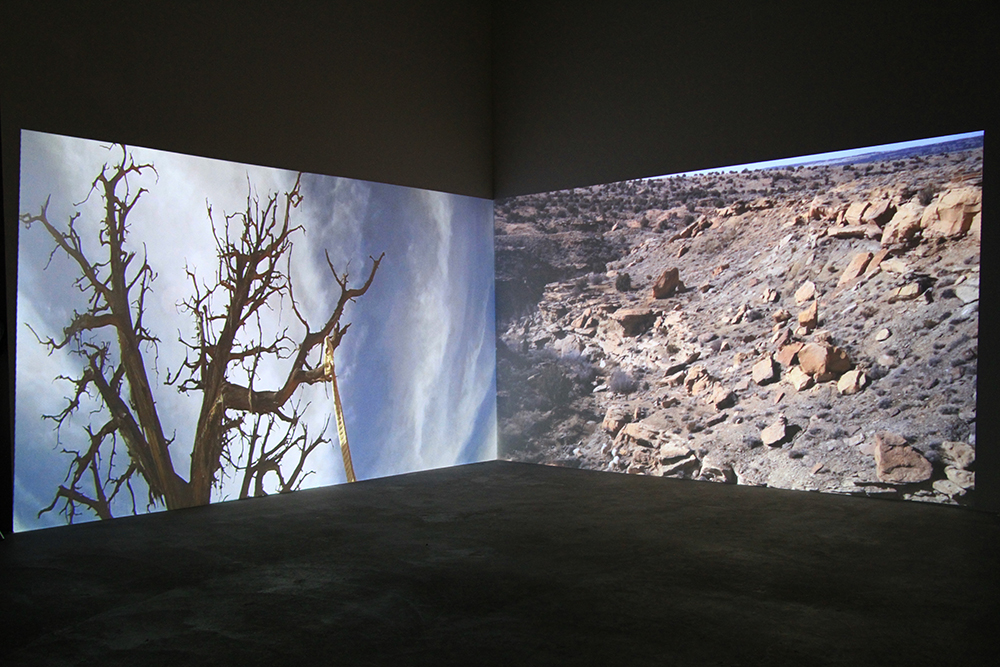Bloomberg New Contemporaries: The New Old Masters

Heather Garner observes a blending of new ideas and old techniques in the latest edition of New Contemporaries…
On the 65th anniversary of Bloomberg New Contemporaries, the viewer is promised a snap-shot of the state of contemporary art, in the form of 55 undergraduates, postgraduates and recent graduates of art courses from around the UK. If this is indeed a glimpse into tomorrow’s contemporary artists and their practice, what can we gather about its wider cultural significance?
‘WE’RE ALL VERY DISAPPOINTED’ is a statement that literally greets the visitor on entering the exhibition space, in the form of Alice Hartley’s screen-printed wall display. A collective artist statement, perhaps? The thought of a generation, maybe? It may even be an anticipation of the criticisms that may eventually come to the art works or the exhibition itself. Whatever the intended or interpreted meaning, this statement seems to echo something of the general zeitgeist of youth culture today.
With recent austerity and government cuts to the arts across the country, it is easy to glean the disappointment of art students as a result of underfunding and financial pressure. There are no extravagant artworks that echo the wealth of a Damien Hirst or a Jeff Koons to be found in this exhibition. Most of the artworks on display perhaps reflect the austerity that is forced upon them through the use of materials such as builder’s sand, children’s playdoh, dust sheets, unfolded cardboard boxes, tights and traditional drawing techniques.
This is perhaps none more evident than in the significant amount of video art that has been selected for the 2014 exhibition, most of which are displayed on televisions on traditional white plinths. Such a medium requires little to no specialist equipment and can be filmed on a smartphone and uploaded on to any computer and is, perhaps, a medium born out of the Do It Yourself ethos when money is tight. It is an immediate and cost efficient form of expression.
Artist Matthew Humphreys’ video Goodbye (2014) seems to epitomise the stripped-back ethos that may be interpreted here. The poignancy of a farewell is captured to heart-breaking effect as he departs from his deaf and aging parents at the doorstep of their house over a period of three years. There are no staged camera set ups or pre-planned dialogue: it is simply communicating the universality and inevitability of saying goodbye.
Victoria Grenier, however, emphasises the lighter side of life through the importance of play: something that is all too easily forgotten. Whilst wearing handmade boots that resemble the gaping jaws of a menacing shark, Grenier improvises a self-conscious yet charming dance: the overall effect looks like a home video complete with 1980s style, special effect backdrops.
Viewing these pieces through the prism of austerity, it makes one wonder: is the artist’s medium and therefore aesthetic always altered in times of crisis? And what does this mean for the future of British art?
The less than optimistic title of art critic Donald Kuspit’s 2004 book The End of Art makes the case that art is no longer reliant on aesthetic significance. The ‘Post-art’ generation is characterised by the division of intellect and aesthetics. The notion that the banal can be elevated to the status of the mythical is claimed to have made art, as a visual and aesthetic medium, redundant.
Kuspit, instead, refers us to a new understanding of art and artists – ‘the New Old Masters’. When Kuspit uses this term he is not simply referring to the most recent artists who use the same techniques as the old masters, instead he is describing the future of art. In this sense, he suggests the future of art need not be limited to the conceptual but combines the intellect and innovation of the new with the humanism and spiritual qualities of the old.
To my mind, this is exactly what this exhibition represents: a move towards the blending of new ideas and old techniques, an understanding that is perhaps reflected in the decision to hold the new contemporaries in an old museum. A new generation of artists that has the political, social and innovative nous of Post-art, but the aesthetic and humanistic qualities of the old masters.
Henry Hussey’s politically-driven tapestry entitled The Guardian (2013) seems to be a perfect example of this union. Newspaper headlines and symbolic imagery of classical sculpture and disembodied hands reaching out to an unknown entity adorn this tapestry like the dada-esque collages of the 1920s.
Whilst Camille Summers-Valli’s Black Mesa (2014) touches upon the increasingly important issue of environmentalism and how the coal mining industry that threatens the Navajo peoples heritage and connection to the landscape. Set against the stunning back-drop of the desert, the film invokes the raw power of nature that may be drawn from the landscape paintings of the Romantic era.
If Bloomberg New Contemporaries has indeed provided the public with a snap-shot of contemporary art and culture, then from this year’s selection the art scene is as self-aware and politically astute as ever. But with arts courses and institutions feeling the effects of economic cuts, this exhibition seems to be an optimistic nod to the continued creativity of the arts scene today.
It is safe to say that art is in the capable hands of the New Old Masters. Perhaps, we shouldn’t be so disappointed after all.
Heather Garner
This review was the result of a public #BeACritic afternoon for aspiring critics, hosted by The Double Negative, at the press view of Bloomberg New Contemporaries 2014 — more here
Read more on the #BeACritic campaign here
Bloomberg New Contemporaries continues at the World Museum, Liverpool until Sunday 26 October 2014. It then travels to the ICA, London from 26 November 2014 until 25 January 2015
Image: courtesy Camille Summers-Valli, Black Mesa, 2014. Still from video installation





